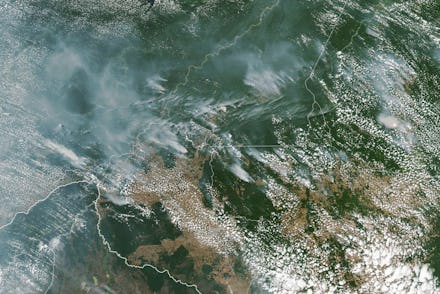The Amazon has been on fire for three weeks. Here's why you're only hearing about it now.

The sky in São Paulo, Brazil, turned pitch black at 3 p.m. on Monday. What should have been a bright afternoon suddenly became a bleak night. Last week, NASA produced photos from space showing smoke coming from the Amazon like a hazy cloud leaving burned forest in its wake. Within the next couple days, news outlets like CBS and CNN slowly began churning out the cause: The Amazon rainforest was on fire.
Then came the most shocking news: It's been on fire for about three weeks. As more images of the destruction, suspected to be exacerbated by deforestation efforts, emerged, folks on social media began to feel angry. How did it get this far and grow this big with seemingly barely a peep?
The answer is difficult to find. But Moira Birss, campaign director of Amazon Watch, a nonprofit dedicated to the conservation of the rainforest, suspects it has to do with the level of visibility. According to Birss, the plight of the Amazon is nothing new — it's been an ongoing battle for many years now.
"Indigenous people of the Amazon have been sounding the alarm about risks to the rainforest for years, and resisting the destruction, sometimes at the cost of their own lives," said Birss. "Unfortunately, it seems the Amazon has to burn before the world pays attention."
It's a depressing thought, but a very realistic possibility. Many major news outlets didn't seem to kick into gear until videos and pictures from a shadowed São Paulo appeared online, causing a sensation on social media.
But seeing the Amazon — known as the "Lungs of the Earth" for producing 20 percent of the oxygen in the planet's atmosphere, as well as for its vast greenery and wealth of biodiversity — going up in a large blaze has been heartbreaking for some of the people who are just learning about the event. Although wildfires occur naturally in forests to keep them healthy, clearing out dead trees and brush to create fertile soil for new seedlings, the humidity in the Amazon makes natural wildfires of this scale less common than in other areas.
"The state of Amazonas, in particular, has seen well above average daily fire activity through August so far," a wildfire emissions scientist told Vice. According to Reuters, Brazil's space research center, INPE, stated the frequency of fires in the Amazon has increased nearly 83 percent from last year. According to CNN, there have already been over 72,000 fires in Brazil this year.
On Twitter, the #AmazonRainforest hashtag has finally ranked as one of the top five trends, after a morning struggle against Spider-Man and Trump statements. Users are expressing feelings of helplessness and frustration, wishing they knew about it earlier.
For others, this is also the first time they've heard about the harmful actions of Brazil's newly elected president, Jair Bolsonaro. According to The Independent, he has dedicated himself to destroying the rainforest to provide more space for development, hoping to attract businesses. His flippant attitude towards the ecosystem and the indigenous people of the Amazon has emboldened local ranchers to clear out more space for their animals.
"I used to be called Captain Chainsaw," the publication quoted Bolsonaro as saying. "Now I am Nero, setting the Amazon aflame."
The president spoke up during the furor over the fires in the Amazon, blaming it on NGOs and environmentalists looking to discredit him. As multiple news outlets noted, he did not provide any names or evidence of such conspiracy against him.
It feels like a waterfall of terrible revelations and upsetting news for many people concerned about the Earth. But Birss wants to use this event to encourage people to support the preservation of the Amazon.
"Now that the world is finally paying attention, I hope people take action in addition to tweet and read articles," said Birss. Distance doesn't have to be an obstacle to doing one's part. "[People] can lobby governments that want to enter trade agreements with Brazil, reject the companies that are profiting off the destruction, and support the indigenous and ally organizations that are resisting every day."
A two-year-old article from The Guardian pointed at corporations like Pepsico, Unilever, and Nestlé playing complicit roles in illegal deforestation. These companies don't explicitly state they encourage deforestation, but they quietly benefit from the plantations that spring up after the space is cleared. These plantations grow ingredients, such as palm trees used to make palm oil, that are a part of the companies' products.
According to an Amazon Watch report, this practice is still a huge problem today and the conflict between development and nature will only become worse. Both Amazon wildlife and indigenous people have died trying to protect their lands. In July, The New York Times reported on the death of an indigenous leader — murdered by miners who invaded a village within a protected area.
If anything, this event has shown that regular folks on social media can shine the brightest spotlight on a current event faster than major news outlets.
This is why rainforest conservation groups like Amazon Watch, Rainforest Action Network, and the Rainforest Alliance have been trying to work with global activists and indigenous people since the '90s. These groups have encouraged the international community to stand against the destruction and push back against the death of one of the most important, and unique, places on Earth. Without the constant help and support from regular citizens, the devastation of the Amazon will just fade into the background once again.